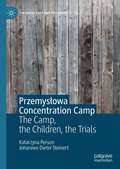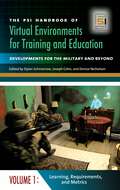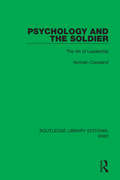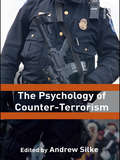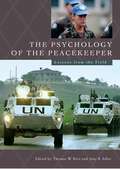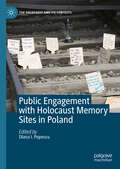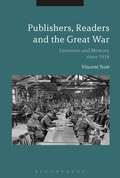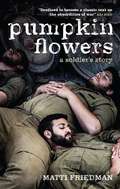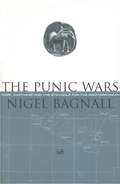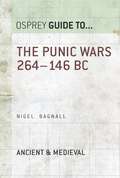- Table View
- List View
Prussian Reserve, Militia & Irregular Troops 1806–15 (Men-at-Arms #192)
by Peter Hofschröer Bryan FostenIrregular, semi-regular and reserve formations comprised a substantial part of the armed forces at the disposal of the Prussian Army throughout the Napoleonic Wars, particularly during the campaigns of the Wars of Liberation, 1813-15. The scale of the uprising of 1813 required the mobilization of all available forces and the utilization of all available equipment, and meant that the Prussian Army of the Wars of Liberation was very much a patchwork affair. This book examines and illustrates the reservists (or Kruemper), the Freikorps and foreign units, and the militia who fought in the Prussian Army.
Prussian Reserve, Militia & Irregular Troops 1806–15 (Men-at-Arms)
by Peter Hofschröer Bryan FostenIrregular, semi-regular and reserve formations comprised a substantial part of the armed forces at the disposal of the Prussian Army throughout the Napoleonic Wars, particularly during the campaigns of the Wars of Liberation, 1813-15. The scale of the uprising of 1813 required the mobilization of all available forces and the utilization of all available equipment, and meant that the Prussian Army of the Wars of Liberation was very much a patchwork affair. This book examines and illustrates the reservists (or Kruemper), the Freikorps and foreign units, and the militia who fought in the Prussian Army.
Prussian Staff & Specialist Troops 1791–1815 (Men-at-Arms #381)
by Christa Hook Peter HofschröerThe origins of what would become the German General Staff of the late 19th and 20th centuries probably the most professional military machine in the world can be traced to the Prussian Army of the French Revolutionary and Napoleonic Wars. This concise study, concluding the author's series of five titles on the Prussian Army of 1792–1815, covers the staff; the reforms in tactical employment of all-arms brigades (which, contrary to received opinion, pre-dated the disasters of Jena and Auerstedt in 1806); the artillery and other technical troops; and regimental colours and standards. Among the illustrations are rare diagrams from the artillery drill manual of the day.
Prussian Staff & Specialist Troops 1791–1815 (Men-at-Arms #381)
by Christa Hook Peter HofschröerThe origins of what would become the German General Staff of the late 19th and 20th centuries probably the most professional military machine in the world can be traced to the Prussian Army of the French Revolutionary and Napoleonic Wars. This concise study, concluding the author's series of five titles on the Prussian Army of 1792–1815, covers the staff; the reforms in tactical employment of all-arms brigades (which, contrary to received opinion, pre-dated the disasters of Jena and Auerstedt in 1806); the artillery and other technical troops; and regimental colours and standards. Among the illustrations are rare diagrams from the artillery drill manual of the day.
Przemysłowa Concentration Camp: The Camp, the Children, the Trials (The Holocaust and its Contexts)
by Katarzyna Person Johannes-Dieter SteinertThis book explores one of the most notorious aspects of the German system of oppression in wartime Poland: the only purpose-built camp for children under the age of 16 years in German-occupied Europe. The camp at Przemysłowa street, or the Polen-Jugendverwahrlager der Sicherheitspolizei in Litzmannstadt as the Germans called it, was a concentration camp for children. The camp at Przemysłowa existed for just over two years, from December 1942 until January 1945. During that time, an unknown number of children, mainly Polish nationals, were imprisoned there and subjected to extreme physical and emotional abuse. For almost all, the consequences of atrocities which they endured in the camp remained with them for the rest of their lives. This book focuses on the establishment of the camp, the experience of the child prisoners, and the post-war investigations and trials. It is based on contemporary German documents, post-war Polish trials and German investigations, as well as dozens of testimonies from camp survivors, guards, civilian camp staff and the camp leadership
The PSI Handbook of Virtual Environments for Training and Education [3 volumes]: Developments for the Military and Beyond [3 volumes] (Technology, Psychology, and Health)
The increasingly complex environment of the 21st century demands unprecedented knowledge, skills and abilities for people from all walks of life. One powerful solution that blends the science of learning with the technological advances of computing is Virtual Environments. In the United States alone, the Department of Defense has invested billions of dollars over the past decade to make this field and its developments as effective as possible. This 3-volume work provides, for the first time, comprehensive coverage of the many different domains that must be integrated for Virtual Environments to fully provide effective training and education. The first volume is dedicated to a thorough understanding of learning theory, requirements definition and performance measurement, providing insight into the human-centric specifications the VE must satisfy to succeed. Volume II provides the latest information on VE component technologies, and Volume III offers discussion of an extensive collection of integrated systems presented as VE use-cases, and results of effectiveness evaluation studies. The text includes emerging directions of this evolving technology, from cognitive rehabilitation to the next generation of museum exhibitions. Finally, the handbook offers a glimpse into the future with this fascinating technology.This groundbreaking set will interest students, scholars and researchers in the fields of military science, technology, computer science, business, law enforcement, cognitive psychology, education and health. Topics addressed include guidance and interventions using VE as a teaching tool, what to look for in terms of human-centered systems and components, and current training uses in the Navy, Army, Air Force and Marines. Game-based and long distance training are explained, as are particular challenges such as the emergence of VE sickness. Chapters also highlight the combination of VE and cybernetics, robotics and artificial intelligence.
Psychoanalysis, Historiography, and the Nazi Camps: Accounting for Survival (The Holocaust and its Contexts)
by Dan StoneIn the postwar years, Dutch survivors Eddy de Wind, Louis Micheels, and Elie A. Cohen, who went on to become practicing psychoanalysts, penned accounts of their survival of the Nazi camps. Their sober assessments contrast sharply with those by Bruno Bettelheim and Viktor Frankl, which emphasized decisiveness, 'positive thinking', and resistance, missing the fact that many Holocaust victims with those characteristics or other qualities did not survive. De Wind’s, Micheels’ and Cohen’s accounts are more sober, (self-)critical, and shaped by analytical practice. By analyzing them anew and comparing them with accounts by female doctors who survived Block 10 in Auschwitz, this book argues that their theories of survival accord with contemporary sensibilities in psychoanalysis and Holocaust historiography. Psychoanalytic concepts have changed over time in response to greater understanding of the Holocaust and recent Holocaust historiography makes us more receptive to insights that were unfashionable in the first postwar decades.
Psychological Trauma and the Legacies of the First World War
by Jason Crouthamel and Peter LeeseThis transnational, interdisciplinary study of traumatic neurosis moves beyond the existing histories of medical theory, welfare, and symptomatology. The essays explore the personal traumas of soldiers and civilians in the wake of the First World War; they also discuss how memory and representations of trauma are transmitted between patients, doctors and families across generations. The book argues that so far the traumatic effects of the war have been substantially underestimated. Trauma was shaped by gender, politics, and personality. To uncover the varied forms of trauma ignored by medical and political authorities, this volume draws on diverse sources, such as family archives and narratives by children of traumatized men, documents from film and photography, memoirs by soldiers and civilians. This innovative study challenges us to re-examine our approach to the complex psychological effects of the First World War.
Psychology and the Soldier: The Art of Leadership (Routledge Library Editions: WW2 #25)
by Norman CopelandThis book, first published in 1944, stresses the point that there is no shortcut to successful wartime leadership, and pays a close analysis to the attributes that contribute to being a sound leader of soldiers. Written in the middle of the Second World War, this book gives us valuable insights into the values and training of the British Army in the second half of the war.
Psychology and the Soldier: The Art of Leadership (Routledge Library Editions: WW2 #25)
by Norman CopelandThis book, first published in 1944, stresses the point that there is no shortcut to successful wartime leadership, and pays a close analysis to the attributes that contribute to being a sound leader of soldiers. Written in the middle of the Second World War, this book gives us valuable insights into the values and training of the British Army in the second half of the war.
The Psychology of Counter-Terrorism (Political Violence)
by Andrew SilkeThis edited book explores how psychology can be used to improve our understanding of terrorism and counterterrorism. This work firstly aims to provide balanced and objective insight into the psychology of terrorists; what their motivations are, what keeps them involved in terrorist groups, and what eventually forces most to end their active involvement in terrorism. Secondly, the contributors focus on the challenging issue of how to respond to terrorism. These chapters provide information for those concerned with short-term tactical problems (e.g. interviewing), as well as those looking towards the more long-term strategic questions of bringing an entire terrorist campaign to an end. Ultimately, the individuals involved in terrorism require a more complex response from society than simply a quest for their apprehension. Believing inaccurate and misleading characterizations leads inevitably to damaging policies and deficient outcomes and campaigns of violence are needlessly prolonged. It is from this perspective that the concern arises with how researchers – and the policy makers guided by them – perceive the psychology of terrorists and of terrorism. This innovative book will be of great interest to students of terrorism and counter-terrorism, security studies, psychology and politics, as well as security professionals and military colleges.
The Psychology of Counter-Terrorism (Political Violence)
by Andrew SilkeThis edited book explores how psychology can be used to improve our understanding of terrorism and counterterrorism. This work firstly aims to provide balanced and objective insight into the psychology of terrorists; what their motivations are, what keeps them involved in terrorist groups, and what eventually forces most to end their active involvement in terrorism. Secondly, the contributors focus on the challenging issue of how to respond to terrorism. These chapters provide information for those concerned with short-term tactical problems (e.g. interviewing), as well as those looking towards the more long-term strategic questions of bringing an entire terrorist campaign to an end. Ultimately, the individuals involved in terrorism require a more complex response from society than simply a quest for their apprehension. Believing inaccurate and misleading characterizations leads inevitably to damaging policies and deficient outcomes and campaigns of violence are needlessly prolonged. It is from this perspective that the concern arises with how researchers – and the policy makers guided by them – perceive the psychology of terrorists and of terrorism. This innovative book will be of great interest to students of terrorism and counter-terrorism, security studies, psychology and politics, as well as security professionals and military colleges.
The Psychology of Strategy: Exploring Rationality in the Vietnam War
by Kenneth PayneHow do strategists decide what they wish to achieve through war, and how they might accomplish it? And why does their understanding of violence regularly turn out to be wrong? In seeking answers to these questions Kenneth Payne draws on the study of psychology to examine strategic behaviour during the Vietnam War. He explores the ways in which cognitive biases distort our sense of our own agency and our decision-making, arguing that much of the latter is emotional, shaped by unconscious processing and driven by a prickly concern for social esteem. The Nixon and Johnson administrations both proved susceptible to the processes that are familiar to students of modern neuroscience and psychology, but perhaps less appreciated within strategic studies. US strategists in the Vietnam era miscalculated in ways that would surprise rational theorists, but not evolutionary psychologists: they exaggerated the stakes, embraced risky and overly optimistic solutions, and failed to appreciate the limits of force to shatter the enemy's resolve. Their concern for reputation led to escalation, based on a flawed conception of what such escalation could achieve. The Vietnam conflict provides an excellent illustration that war is an inherently psychological phenomenon. This challenges abstract notions of rationality in strategic affairs, suggesting that the strategists -- much like the rest of us -- are strangers to themselves.
The Psychology of Strategy: Exploring Rationality in the Vietnam War
by Kenneth PayneHow do strategists decide what they wish to achieve through war, and how they might accomplish it? And why does their understanding of violence regularly turn out to be wrong? In seeking answers to these questions Kenneth Payne draws on the study of psychology to examine strategic behaviour during the Vietnam War. He explores the ways in which cognitive biases distort our sense of our own agency and our decision-making, arguing that much of the latter is emotional, shaped by unconscious processing and driven by a prickly concern for social esteem. The Nixon and Johnson administrations both proved susceptible to the processes that are familiar to students of modern neuroscience and psychology, but perhaps less appreciated within strategic studies. US strategists in the Vietnam era miscalculated in ways that would surprise rational theorists, but not evolutionary psychologists: they exaggerated the stakes, embraced risky and overly optimistic solutions, and failed to appreciate the limits of force to shatter the enemy's resolve. Their concern for reputation led to escalation, based on a flawed conception of what such escalation could achieve. The Vietnam conflict provides an excellent illustration that war is an inherently psychological phenomenon. This challenges abstract notions of rationality in strategic affairs, suggesting that the strategists -- much like the rest of us -- are strangers to themselves.
The Psychology of the Peacekeeper: Lessons from the Field (Psychological Dimensions to War and Peace)
In this remarkable volume, a multinational team of scientists catalogs the stressors and benefits for combat-trained soldiers deployed on missions where they are told to hold their fire and assume the role of peacekeeper. Theory and direct research with peacekeepers is incorporated. Missions covered include, but are not limited to, peacekeeping operations in Haiti, Somalia, Bosnia, Kosovo, Iraq, and Lebanon. The terminology of peacekeeping and military operations is listed. The stressors, threats, dangers, frustrations, and benefits of the peacekeeper role are described in dramatic detail, with additional attention to the Peacekeeper Stress Syndrome.With the goal of increasing peacekeeper health and well-being, which in turn increases the likelihood of establishing a stable peace, this volume also addresses interventions and preventative measures. The extent of psychological distress and disorders following peacekeeping operations is documented. Interventions are recommended for various phases of deployment, in order to minimize the likelihood of post-deployment psychological problems. Experts in social, industrial/organizational, health, clinical, and cross-cultural psychology contribute to a multi-dimensional perspective. Each chapter author reports psychological research with military personnel in peacekeeping operations.
Ptolemy I: King and Pharaoh of Egypt
by Ian WorthingtonWhen Rome defeated the forces of Antony and Cleopatra and annexed Egypt, the rule of the longest-lived of the Hellenistic dynasties and one of the most illustrious in Egyptian history came to an end. For nearly three hundred years, the Macedonian dynasty known as the Ptolemaic had controlled Egypt and its mixed population of Egyptians, Greeks, Macedonians, and Jews. The founder of this dynasty, Ptolemy I (367-283/2 BC), was a boyhood friend and eventually personal bodyguard of Alexander the Great, who fought alongside Alexander in the epic battles that toppled the Persian Empire, and brought about a Macedonian Empire stretching from Greece to India. After Alexander's death, his senior staff carved up his vast empire, with Ptolemy gaining control of Egypt. There he built up his power base in Egypt, introduced administrative and economic reforms that made his family fabulously wealthy, and by extending Egypt's possessions overseas founded an Egyptian Empire. In addition to his political and military prowess, Ptolemy was an intellectual, who patronized the mathematician Euclid, wrote an important account of Alexander's campaign in Asia, and established the famous Library and Museum at Alexandria, which were the cultural heart of the entire Hellenistic Age. Ptolemy ruled Egypt until he died of natural causes in his early eighties. Ian Worthington's Ptolemy I--the first full-length biography of its kind in English--traces the life of Ptolemy from his boyhood to his reign as king and pharaoh of Egypt. Throughout, he highlights the achievements that profoundly shaped both Egypt's history and that of the early Hellenistic world. He argues that Ptolemy was by far the greatest of Alexander's Successors, and that he was a conscious imperialist who even boldly attempted to seize Greece and Macedonia, and be a second Alexander.
Ptolemy I: King and Pharaoh of Egypt
by Ian WorthingtonWhen Rome defeated the forces of Antony and Cleopatra and annexed Egypt, the rule of the longest-lived of the Hellenistic dynasties and one of the most illustrious in Egyptian history came to an end. For nearly three hundred years, the Macedonian dynasty known as the Ptolemaic had controlled Egypt and its mixed population of Egyptians, Greeks, Macedonians, and Jews. The founder of this dynasty, Ptolemy I (367-283/2 BC), was a boyhood friend and eventually personal bodyguard of Alexander the Great, who fought alongside Alexander in the epic battles that toppled the Persian Empire, and brought about a Macedonian Empire stretching from Greece to India. After Alexander's death, his senior staff carved up his vast empire, with Ptolemy gaining control of Egypt. There he built up his power base in Egypt, introduced administrative and economic reforms that made his family fabulously wealthy, and by extending Egypt's possessions overseas founded an Egyptian Empire. In addition to his political and military prowess, Ptolemy was an intellectual, who patronized the mathematician Euclid, wrote an important account of Alexander's campaign in Asia, and established the famous Library and Museum at Alexandria, which were the cultural heart of the entire Hellenistic Age. Ptolemy ruled Egypt until he died of natural causes in his early eighties. Ian Worthington's Ptolemy I--the first full-length biography of its kind in English--traces the life of Ptolemy from his boyhood to his reign as king and pharaoh of Egypt. Throughout, he highlights the achievements that profoundly shaped both Egypt's history and that of the early Hellenistic world. He argues that Ptolemy was by far the greatest of Alexander's Successors, and that he was a conscious imperialist who even boldly attempted to seize Greece and Macedonia, and be a second Alexander.
Public Engagement with Holocaust Memory Sites in Poland (The Holocaust and its Contexts)
by Diana I. PopescuThis book aims to address a neglected field of research by providing evidence-based insights into how contemporary visitors of different national and generational background, especially those of Polish and Jewish descent, experience and reflect on their visits, or on living in the proximity of different sites of memory across Poland, including former concentration and death camps, ghetto sites, and other physical sites such as museums with a connection to the Holocaust.
Publishers, Readers and the Great War: Literature and Memory since 1918
by Vincent TrottLiterature is at the heart of popular understandings of the First World War in Britain, and has perpetuated a popular memory of the conflict centred on disillusionment, horror and futility. This book examines how and why literature has had this impact, exploring the role played by authors, publishers and readers in constructing the memory of the war since 1918. It demonstrates that publishers were as influential as authors in shaping perceptions of the conflict, and it provides a detailed analysis of critical and popular responses to war books, tracing the evolution of readers' attitudes to the war between 1918 and 2014. By exploring the cultural legacy of the war from these two previously overlooked perspectives, Vincent Trott offers fresh insights regarding the emergence of a collective memory of the First World War in Britain.Drawing on a broad range of primary source material, including publishers' correspondence, dust jackets, adverts, book reviews and diary entries, and examining canonical authors such as Wilfred Owen, Siegfried Sassoon and Vera Brittain alongside long-forgotten texts and more recent autobiographical works by Harry Patch and Henry Allingham, Publishers, Readers and the Great War provides a rich and nuanced analysis of the climate within which First World War literature was written, published and received since 1918.
Publishers, Readers and the Great War: Literature and Memory since 1918
by Vincent TrottLiterature is at the heart of popular understandings of the First World War in Britain, and has perpetuated a popular memory of the conflict centred on disillusionment, horror and futility. This book examines how and why literature has had this impact, exploring the role played by authors, publishers and readers in constructing the memory of the war since 1918. It demonstrates that publishers were as influential as authors in shaping perceptions of the conflict, and it provides a detailed analysis of critical and popular responses to war books, tracing the evolution of readers' attitudes to the war between 1918 and 2014. By exploring the cultural legacy of the war from these two previously overlooked perspectives, Vincent Trott offers fresh insights regarding the emergence of a collective memory of the First World War in Britain.Drawing on a broad range of primary source material, including publishers' correspondence, dust jackets, adverts, book reviews and diary entries, and examining canonical authors such as Wilfred Owen, Siegfried Sassoon and Vera Brittain alongside long-forgotten texts and more recent autobiographical works by Harry Patch and Henry Allingham, Publishers, Readers and the Great War provides a rich and nuanced analysis of the climate within which First World War literature was written, published and received since 1918.
Pubs and Patriots: The Drink Crisis in Britain during World War One
by Robert DuncanIn the midst of the First World War concern arose as to the virtues of pursuing intoxication at a time of national emergency. As the military front was supposedly let down by drinkers and shirkers at home, attention quickly turned to British drinking practices. Britain, it seemed, was under the duress of a widespread addiction to boozing. When prohibition was deemed too extreme to contemplate, and nationalisation too impractical, the government created an organisation known as the Central Control Board (CCB). This body soon set about reforming the drinking habits of a nation. Loved by a few, but disliked by most, this group was responsible for the most radical and unique experiment in alcohol control ever conducted in Britain. The story of the CCB, how and why it was formed, its history and its legacy upon the British war effort are told within Pubs and Patriots: The Drink Crisis in Britain during World War One.
Pumpkinflowers: A Soldier's Story
by Matti FriedmanIt was just one remote hilltop in an unnamed war in the late 1990s, but it would send out ripples that are still felt today, foreshadowing the chaos of 21st-century conflicts in the Middle East. The hill, in Lebanon, was called the Pumpkin; ‘flowers’ was the military code word for casualties. Part memoir, part reportage and part haunting elegy for lost youth, award-winning writer Matti Friedman’s powerful account follows the band of young soldiers - the author among them - conscripted out of high school into holding this remote outpost, and explores how the task would change them forever. Pumpkinflowers is a lyrical yet devastating insight into the day-today realities of war, and a powerful coming-of-age narrative. Raw and beautifully rendered, this essential chronicle casts an unflinching look at the nature of modern warfare, in which there is never a clear victor and innocence is not all that is lost.
The Punic Wars: Rome, Carthage and the Struggle for the Mediterranean (Guide To... Ser. #16)
by Nigel BagnallThe Punic Wars (264-146BC) sprang from a mighty power struggle between two ancient civilisations - the trading empire of Carthage and the military confedoration of Rome. It was a period of astonishing human misfortune, lasting over a period of 118 years and resulting in the radical depletion of Rome's population and resources and the complete annihilation of Carthage. All this took place more than 2,000 years ago, yet, as Nigel Bagnall's comprehensive history demonstrates, the ancient conflict is remarkable for its contemporary revelance.
The Punic Wars 264–146 BC (Guide to...)
by Nigel BagnallThe three Punic Wars lasted over 100 years, between 264 BC and 146 BC. They represented a struggle for supremacy in the Mediterranean between the bludgeoning land power of Rome, bent on imperial conquest, and the great maritime power of Carthage with its colonies and trading posts spread around the Mediterranean. This book reveals how the dramas and tragedies of the Punic Wars exemplify many political and military lessons which are as relevant today as when Hannibal and Scipio Africanus fought to determine the course of history in the Mediterranean.
The Puppet Boy of Warsaw: A compelling, epic journey of survival and hope
by Eva WeaverI was twelve when the coat was made. Nathan, our tailor and dear friend, cut it for Grandfather in the first week of March 1938. It was the last week of freedom for Warsaw and for us... Even in the most difficult of lives, there is hope. And sometimes that hope comes in the form of a small boy, armed with a troupe of puppets – a prince, a girl, a fool, a crocodile with half-painted teeth....



